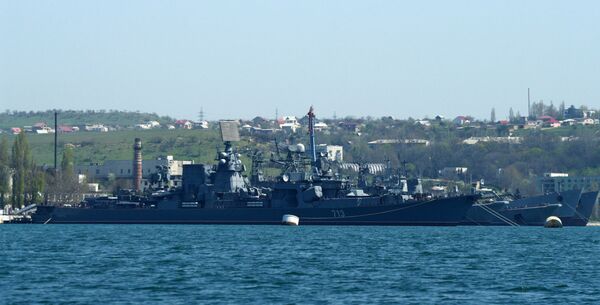On June 9, 1995, in Sochi Russia and Ukraine signed an agreement on basing Russia's Black Sea Fleet and Ukraine's naval forces in Sevastopol. The agreement marked a watershed in the fleet's history.
The dispute over the fleet began on April 5, 1992 when Ukraine's President Leonid Kravchuk signed a decree on urgent measures to build up the Ukrainian armed forces. The decree put the former Soviet Black Sea Fleet under Kiev's control, and all its forces deployed on Ukrainian territory (practically the entire fleet) were to become Ukraine's naval forces. Kiev had no right to make such a decision.
Much diplomatic haggling followed, with Kiev trying to persuade the sailors to swear an oath to Ukraine, make the fleet Ukrainian and confront Moscow with this fact.
On April 15, 1994, Russia and Ukraine signed an agreement on the gradual resolution of the issue. Russia was to get 80% to 85% of all ships and vessels of the fleet. At the same time, Russian diplomats realized the agreement would be tied in with a political treaty between Russia and Ukraine. The Ukrainian side, however, did not want the agreement to be linked to any such political treaty and the issue remained unresolved.
Negotiations had to be re-started. On June 9, 1995 in Sochi, the two countries signed an agreement on separate bases for Russia's Black Sea Fleet and Ukraine's naval forces; Sevastopol was to be the Russian fleet's main base. Property ownership issues were resolved on the basis of an earlier agreement dividing all warehouses fifty-fifty. Russia received 81.7% of all ships and vessels; Ukraine, 18.3%.
The division of the fleet, coupled with heavy spending cuts by comparison with Soviet times, led to a deteriorating balance of forces in the Black Sea and the Mediterranean. In 1991, the Soviet Black Sea Fleet numbered 100,000 personnel and 60,000 factory and office workers and had 835 vessels and ships of practically every class.
The current strength of the fleet is now down to 50 warships and launches, in addition to a few dozen auxiliary vessels. Shore-based aviation and coastal defenses were also greatly reduced. The fleet, once a dominant force in the Black Sea and a rival to NATO in the Mediterranean, is now outnumbered by Turkey's Black Sea naval forces (although it surpasses the fleets of all the other Black Sea countries combined) which makes only sporadic appearances in the Mediterranean.
Meanwhile the situation on Russia's southern borders has become more restive. In 2008, the fleet had to fulfill a number of missions during the five-day war with Georgia.
Nor did Ukraine's naval forces profit from the division. Most were soon written off, while the rest are not battle-worthy.
Russia needs billions of dollars in allocations to restore the Black Sea Fleet's combat potential. With the fleet aging and many of the Soviet-built vessels facing early retirement, there is a clear need for significant supplies of ships and other equipment - from trucks to radars and aircraft.
Igor Korotchenko, a military expert and a member of the Defense Ministry's Public Council, believes that the Black Sea Fleet needs 50 new ships in the next 10 years.
But these requirements are now unlikely to be met. The state armament program for 2010-2020 puts renewing the fleet as its last priority. What will be left of it in 15 years time is hard to tell.
The opinions expressed in this article are the author's and do not necessarily represent those of RIA Novosti.
MOSCOW. (RIA Novosti military commentator Ilya Kramnik)



